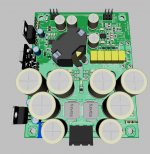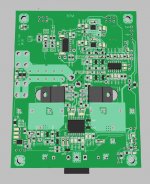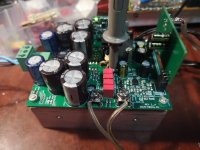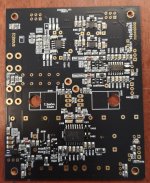0.15 ohm is a high value for on-resistance of a GaNFET, any particular reason for choosing 600V devices and paying that penalty?
Something more like 250V 10 milliohm would reduce device heat dissipation considerably, perhaps allowing the heatsink to just be the PCB. In bridge-mode even lower on-resistance devices become available, 100V 3 milliohm or so, giving 6 milliohm total in bridged. The size and weight advantages (no separate heatsink) can be traded for bigger/better inductors, reducing quiescent dissipation and temperatures even more.
Be interested to see what thermal performance you can get. On and off I am experimenting with a pair of EPC9203 half-bridge modules - not quite that power level, but 1.8 milliohm on-resistance.
Something more like 250V 10 milliohm would reduce device heat dissipation considerably, perhaps allowing the heatsink to just be the PCB. In bridge-mode even lower on-resistance devices become available, 100V 3 milliohm or so, giving 6 milliohm total in bridged. The size and weight advantages (no separate heatsink) can be traded for bigger/better inductors, reducing quiescent dissipation and temperatures even more.
Be interested to see what thermal performance you can get. On and off I am experimenting with a pair of EPC9203 half-bridge modules - not quite that power level, but 1.8 milliohm on-resistance.
Thanks! yes, 4 layer.Nice work, is this a 4-layer-design?
0.15 ohm is a high value for on-resistance of a GaNFET, any particular reason for choosing 600V devices and paying that penalty?
Something more like 250V 10 milliohm would reduce device heat dissipation considerably, perhaps allowing the heatsink to just be the PCB. In bridge-mode even lower on-resistance devices become available, 100V 3 milliohm or so, giving 6 milliohm total in bridged. The size and weight advantages (no separate heatsink) can be traded for bigger/better inductors, reducing quiescent dissipation and temperatures even more.
Be interested to see what thermal performance you can get. On and off I am experimenting with a pair of EPC9203 half-bridge modules - not quite that power level, but 1.8 milliohm on-resistance.
Since the amplifier is essentially a voltage converter and the input current is not equal to the output current in my case, it is better to raise the supply voltage to, for example, +/- 100V. Then the static losses on the channel resistance will be scanty, since the current consumption is very low.
For this board, I expect samples from Transphorm. GAN cascode transistor 600V 110mOhm will be installed. The parameters of these keys are approximately equal to the best 100V silicon transistors.
All options have the right to life. GAN keys in modern case are not very convenient yet.
It seemed to me more interesting to make a universal platform for which you can use GAS keys, or ordinary silicon ones, as cascode. This is also due to the fact that existing solutions for GAN are not very suitable for audio, especially for half-bridge operation.
The results on the video - work on transistors IRFB5615.
The frequency of idling is 750k, the dead time is 7ns. When voltage is +/- 52V at idle, no radiator is required.
While these are preliminary results, I just collected this demo board just three days ago.
The dynamic parameters of the TPH3208 are slightly better than the IRFB5615, because, I think, after optimization, the amplifier can be switched on to the XX without a radiator to a supply voltage of about +/- 75V. For tougher modes, old IRFB4227 will do.
It seemed to me more interesting to make a universal platform for which you can use GAS keys, or ordinary silicon ones, as cascode. This is also due to the fact that existing solutions for GAN are not very suitable for audio, especially for half-bridge operation.
The results on the video - work on transistors IRFB5615.
The frequency of idling is 750k, the dead time is 7ns. When voltage is +/- 52V at idle, no radiator is required.
While these are preliminary results, I just collected this demo board just three days ago.
The dynamic parameters of the TPH3208 are slightly better than the IRFB5615, because, I think, after optimization, the amplifier can be switched on to the XX without a radiator to a supply voltage of about +/- 75V. For tougher modes, old IRFB4227 will do.
Thank!
will be commercial after testing.
At the moment, experiments with galium nitride have not shown better results than silicon transistors.
Nevertheless, the board works fine with IRFB4227. The distortion level is about 0.002% to 1/2 of maximum power and maximum power of 500W RMS.
A little later I will show detailed results
will be commercial after testing.
At the moment, experiments with galium nitride have not shown better results than silicon transistors.
Nevertheless, the board works fine with IRFB4227. The distortion level is about 0.002% to 1/2 of maximum power and maximum power of 500W RMS.
A little later I will show detailed results
more than 1 W above 100dB, unfortunately the measuring stand is not of sufficient resolution.
The noise floor is a tad high ?
- Status
- This old topic is closed. If you want to reopen this topic, contact a moderator using the "Report Post" button.
- Home
- Amplifiers
- Class D
- Amplifier module on driver SI2833




